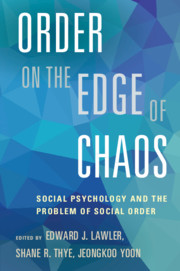Book contents
- Frontmatter
- Contents
- List of Contributors
- Preface
- 1 Social Psychology of Social Order: An Introduction
- 2 The Evolutionary Biology and Sociology of Social Order
- 3 Social Rationality and Weak Solidarity: A Coevolutionary Approach to Social Order
- 4 An Integrative Theory of Action: The Model of Frame Selection
- 5 The Center Cannot Hold: Networks, Echo Chambers, and Polarization
- 6 Social Exchange and Social Order: An Affect Theory Approach
- 7 Institutions, Trust, and Social Order
- 8 Identity Verifi cation and the Social Order
- 9 Identities, Roles, and Social Institutions: An Affect Control Account of Social Order
- 10 The Gender Frame and Social Order
- 11 Status, Power, and Social Order
- 12 Interaction Order: The Making of Social Facts
- 13 The Arts of Together: Social Coordination as Dyadic Achievement
- 14 Dignity as Moral Motivation: The Problem of Social Order Writ Small
- 15 The Legitimacy of Groups and the Mobilization of Resources
- Commentary: Contrasts and Complementarities
- Index
- References
3 - Social Rationality and Weak Solidarity: A Coevolutionary Approach to Social Order
Published online by Cambridge University Press: 05 December 2015
- Frontmatter
- Contents
- List of Contributors
- Preface
- 1 Social Psychology of Social Order: An Introduction
- 2 The Evolutionary Biology and Sociology of Social Order
- 3 Social Rationality and Weak Solidarity: A Coevolutionary Approach to Social Order
- 4 An Integrative Theory of Action: The Model of Frame Selection
- 5 The Center Cannot Hold: Networks, Echo Chambers, and Polarization
- 6 Social Exchange and Social Order: An Affect Theory Approach
- 7 Institutions, Trust, and Social Order
- 8 Identity Verifi cation and the Social Order
- 9 Identities, Roles, and Social Institutions: An Affect Control Account of Social Order
- 10 The Gender Frame and Social Order
- 11 Status, Power, and Social Order
- 12 Interaction Order: The Making of Social Facts
- 13 The Arts of Together: Social Coordination as Dyadic Achievement
- 14 Dignity as Moral Motivation: The Problem of Social Order Writ Small
- 15 The Legitimacy of Groups and the Mobilization of Resources
- Commentary: Contrasts and Complementarities
- Index
- References
Summary
Abstract
Social order is a phenomenon that is constantly produced and reproduced by processes that prominently include evolved capacities of human beings. This view sharply contrasts with a view in which social order is the result of a Leviathan or the result of shared values produced by the socialization of children. From the perspective suggested here, the central question of the microfoundations of social order concerns these evolved capacities, which may jointly be referred to as “social rationality”. Part of social rationality and central to this approach is the dynamics of three overarching goals (mind-sets) in which cognitive and motivational processes are combined: hedonic, gain, and normative goals. An important part of the dynamics of these goals is that they are often in conflict with one another and that their salience changes with changing social circumstances. This also affects self-regulatory capacities. On the micro level, social order can be seen as being governed by the interaction of (macro and micro) social circumstances and the way they affect the changing salience of overarching goals.
The problem of order is traditionally connected with Hobbes and, in sociology, with the way Parsons criticized Hobbes's solution. These two authors also inspired this book. However, the traditional discussion of the problem of order in sociology as it is based on this Leviathan (Hobbes) versus normativity (Parsons) dichotomy is highly misleading because it confounds two problems of order: the microfoundational problem of order (what does the human nature look like that enables humans to produce and reproduce social order in their daily relating and behaving when the right conditions are present); and the institutional problem of order (what institutions are necessary to create a sustainable order in society). Of course, the two problems are linked, but neither Hobbes nor Parsons distinguished them. They failed to problematize the microfoundational problem of order by simply positing a human nature that was based on rationality (in the sense of purposefulness) and a set of preferences (either self-interested preferences or socialized norm-conformity preferences). Both Hobbes and Parsons treated the microfoundational problem of order as if we could leave that to God's creation: God had put humans on this earth as fully developed rational egoists or fully developed rational teachers and learners (socializers of newborn babies and socializees).
- Type
- Chapter
- Information
- Order on the Edge of ChaosSocial Psychology and the Problem of Social Order, pp. 43 - 62Publisher: Cambridge University PressPrint publication year: 2015
References
- 10
- Cited by

